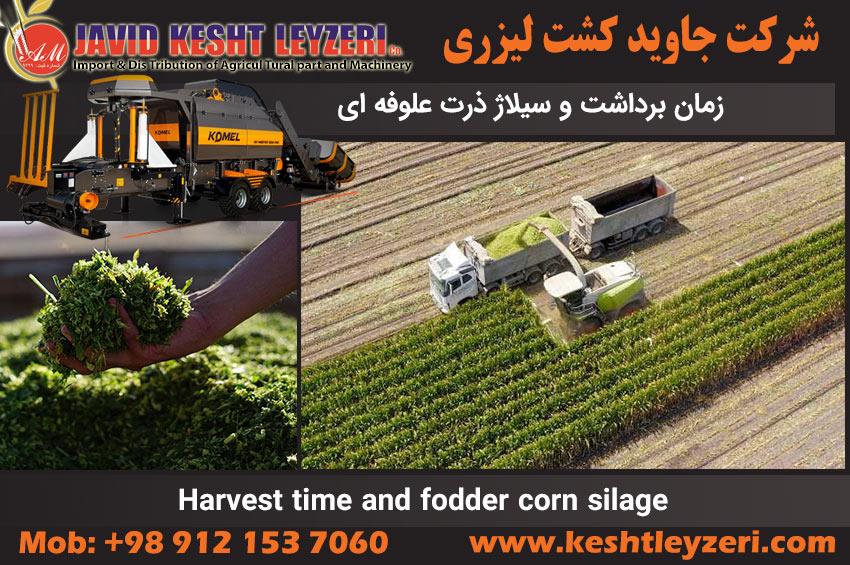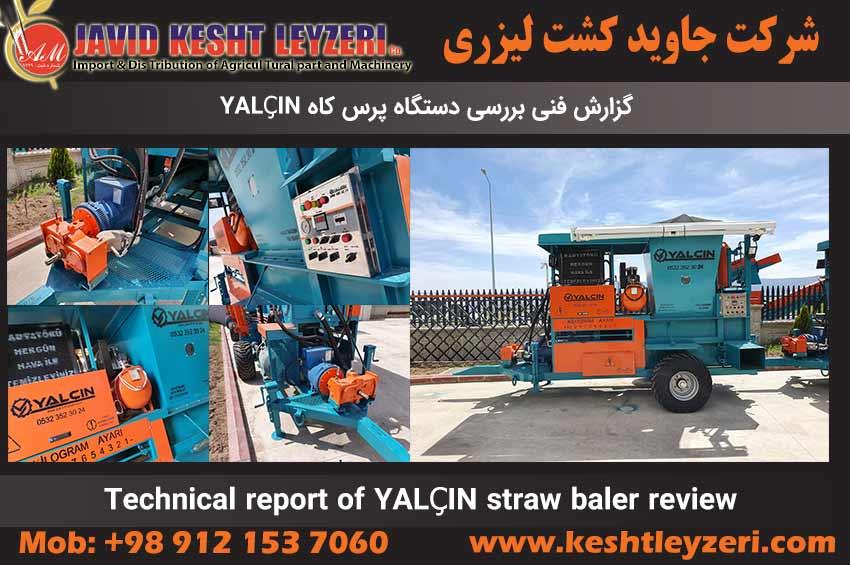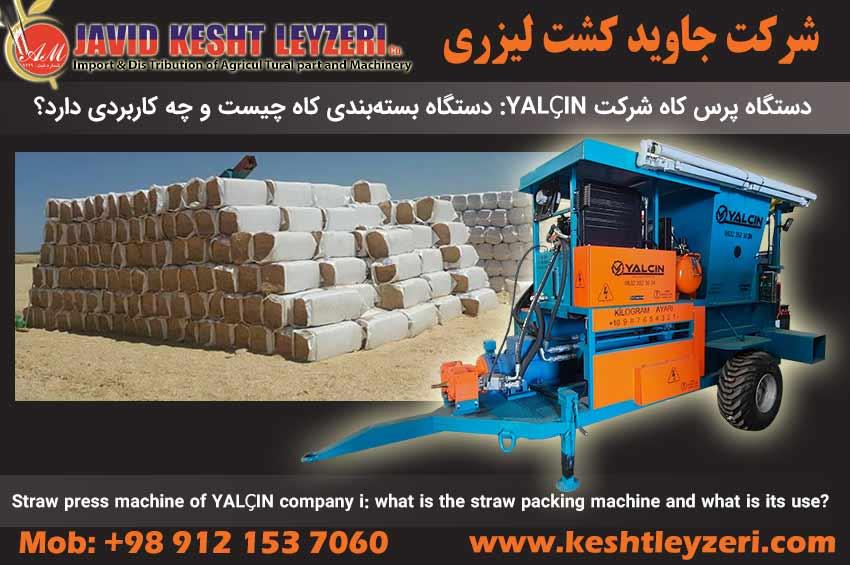
Harvest time and fodder corn silage
javid keshtleyzeri Co.ltd
Silage corn is harvested before seed corn and in the milky-waxy stage (this is when the plant has 70-75% water and by ensiling it, good quality fodder is obtained). It is better to harvest silage corn that is close to The waxy stage should be done depending on the means of harvest. It should be remembered that it takes about 10 days from the end of the milky stage to the waxy stage. (when the cobs have more than 40% of dry matter) in this stage (milky to waxy stage) the digestibility coefficient of organic matter for the whole plant is almost constant.
The digestibility coefficient of silage corn depends on the corn varieties and the percentage of cobs in the total production. The higher the amount of cobs in the total production, the higher the digestibility coefficient will be, so the best time to harvest silage corn is when the dry matter percentage of the plant is about 30% and the amount of cobs is up to the total production.
Fodder corn is a very palatable fodder for cattle and sheep, and it accepts mechanization conditions well. It is compared to when it is consumed as a grain. In a series of experiments, it has been determined that about 50% of dry matter is stored in leaves and stems, and about 37% of nitrogen, 26% of phosphorus, 61% of potash and 79% of calcium are available in leaves and stems. The fodder of this type of corn is rich in carbohydrates and energy-generating substances, while corn is extremely easy to digest and its silage is the best food for fattening animals.
Other factors that caused this plant to spread so much are:
Very high resistance to drought and drought
Its high yield per hectare
Ability to accept mechanization in different stages of planting, harvesting
Accepting successive crops for several years
The major contribution and increasing role of corn in providing food needed by humans, livestock and poultry and industrial uses
Fodder value of corn seeds and straw
One of the most important factors in the operation and continuity of the production of corn fodder silage fermentation and packaging factories is to have agricultural land under the cultivation of fodder corn to harvest and process the packaged corn fodder silage in all months of the year...
Corn fodder is the most appropriate time to harvest and chop corn when the corn seeds or so-called cobs are in a pasty or milky state, and at this time, when the fields cultivated with corn fodder are harvested and chopped, the cobs or corn seeds are close to Most of them will be crushed during chopping and shredding, and they will lose the usual shape and appearance of the corn grain in the chopped fodder, and the crushed seeds will have their content with nutritional value in the whole corn fodder. This should not be a concern on the part of ranchers and consumers that the corn fodder must contain corn seeds with their usual shape and appearance in the corn fodder in a healthy way.
Livestock farmers always try to dry and store some of the green fodder produced in spring and summer for winter consumption of their animals. But firstly, drying fodder causes a sharp drop in it, and secondly, it is not always possible to dry fodder. Therefore, in areas (such as mountainous and humid areas) where it is not possible to dry fodder, animal food can be stored and stored in silage form.
With the arrival of the harvest season of fodder corn and the preparation of corn silage, which is considered one of the unavoidable necessities of industrial animal husbandry for the preparation of very valuable, juicy, cheap and available fodder in all seasons, we take advantage of the opportunity. And we remind you some tips about its preparation.
The conditions under which wet crops are subject to controlled fermentation are called ensiling. During this process, agricultural products (such as fodder) are fermented under anaerobic conditions by microorganisms and their fermentable sugars are converted into valuable compounds such as lactic acid. Silo's acidic state (PH<4) makes this possible. It means that it can be kept fresh and juicy for a long time (even years). Corn silage is rich in energy.
Scientific studies have shown that the soil contains a large amount of microorganisms that produce butyric acid (a silage weakening agent). We cover the pores of the silo walls with cement lining. We drain the silo well and preferably wash the silo with a 3-5% acid solution to destroy the unwanted microorganisms in the silo building.
The best time to harvest corn fodder is when the humidity of the plant is around 65 to 70 percent. In this case, the corn seeds have turned into a paste and the plant body is still green. The most common and practical way to determine the right time to harvest silage is if you press the corn seeds with your fingernail, the nail mark will remain on the grain, or if you divide the corn body into two halves, the white line known as The milk line is marked as a circle in the middle of the seeds.
We grind the corn fodder during the day, because the soluble sugar of the fodder is at its highest during the day. The best size for chopping the plant is 1 to 3 cm pieces. We transport the chopped fodder from the field to the silo quickly and without delay, and even if possible, the operations of filling, pounding and compressing the fodder mass are done during the same day.
The appropriate pressing speed of the fodder mass will play the best role in the quality of the produced corn silage. The purpose of compressing silage fodder is to remove as much air as possible between the fodder pieces; Because the oxygen in the silo, according to the chemical formula, causes the oxidation of the sugars in the fodder and their waste.
The heat of the produced water from the silo (from the end to the beginning of the silo) is the best indicator of how the fodder is compressed.
The operation of filling and pressing the silo should be done across the width of the silo, not along its length. Because the high movement of the loader on the fodder mass destroys its plant tissue.
Immediately after filling the silo, we completely cover it with a strong plastic cover and carefully block all air infiltration channels. Inaccuracy in this operation will cause oxygen to enter the silo and cause oxidation.
After covering the silo with a plastic cover, we use sand bags and cement blocks to close the air infiltration channels to the silo and block the air infiltration path carefully. When filling the silo, different additives can be used to improve the quality of the produced silage, depending on the conditions. Today, in many parts of the world, biological products are used as silage additives. The nutritional value of well-processed corn silage is about 85-90% of the total nutritional value of fresh fodder, which is a significant number. Storing fodder in silos and making corn silage takes up very little space compared to dry storage materials. At the same time, by ensiling the fodder, the risk of fire will be eliminated and the safety factor of the stored fodder will increase.
If, for any reason, the moisture content of the prepared corn fodder is too high, in order to avoid wasting the plant juice of the fodder, which is a very valuable material, straw can be spread on the bottom of the silo at a height of 30 to 40 cm to reduce the moisture. Absorb excess.
If corn silage is prepared in a proper way, it can be stored for years without being damaged; But the minimum time required to open the silo and consume it is about one month if no biological additives are used, and if these additives are used, this period is reduced to one week.
We all know that the biggest problem in preparing a good corn silage in most farms in Iran is low dry matter and low corn grain. Although corn silage plays an essential role in dairy farms and considering the general problems of this fodder in Iran, many managers and experts still fail to manage traditional and non-industrial silos. The best time to harvest corn is when the milky line reaches two-thirds of the grain and its dry matter is around 30-35%. Harvesting fodder with high moisture (dry matter less than 28%) will reduce the nutritional value of silage, due to the release of a large amount of nutrients and sugar in the form of effluent. Twenty to 25 cm of the beginning of the corn stem is devoid of nutrients and unusable for livestock due to contamination with manure and soil.
There are cattle around many farms, roads and places of passage. One of the management problems of traditional and non-industrial silos in livestock farms is excessive fodder contamination before silage. It should be noted that this fodder is infected with many pathogenic bacteria, fungi and viruses in addition to the beneficial microbial load.
The remaining of chemical fertilizers in the plant, which is caused by wrong irrigation, improper fertilization time, excessive use of fertilizers and low-quality fertilizers, will bring many risks for livestock, from poisoning attacks, abortions and birth defects. After opening the silo, the metabolites from these fertilizers can be seen in different colors. Therefore, about 15 days before harvest, no fertilization is done to prevent contamination of corn fodder. In our collection, the best time to harvest corn is in the early hours of the day (5:00 AM to before the midday heat). Because the sugar of the plant is at its highest level and the influx of nitrates and nitrogenous fertilizers has not yet taken place due to direct sunlight to the nutritious parts of the plant.
The size of the plant chopper has a direct relationship with the amount of its dry matter.
The higher the humidity of the plant and the lower its dry matter, the plant must be cut into larger pieces to prevent nutrients from leaving with the waste water.
A product with dry matter between 28 and 30% with about 1.3 to 1.5 cm, a product with dry matter between 20 and 28%, about 1.5 to 2 cm and a product with dry matter less than 20% should be larger than 2.5 cm be crushed
Chopper with low and slow blades, not paying attention to the amount of dry matter of the plant and excessive pounding and improper coating cause poor quality of the final product.
In our collection, silos are filled with maximum power and in a very short period of time.
Ensiling during rains causes a drop in nutritional value.
Trucks are not allowed to enter the silo so that the contamination of the tires does not enter the silo.
Loader tires, trucks and all vehicles are washed only with water (they are not in contact with any disinfectant).
The higher the rubber level in silage crushing with a loader, the better the crushing will be as a result of the release of more oxygen and the activity of aerobic bacteria will be less, while the crushing of tissues, which leads to the exit of a lot of water from the silo, will also be less. Excessive threshing will cause a severe reduction of nutrients due to excessive water exit from the silage and the loss of the plant's nutritious tissue.
Tamping should start when the height of the unloaded product reaches at least 1 meter, (so as not to crush the plant) and continue until the surface of the silo is uniform and the rubber does not sink into it. The sides of the walls and the end of the silo should be carefully After emptying every 100 tons of fodder, threshing should be done quickly and carefully.
The water coming out of the silo after 24 hours will be the most dangerous substance available.
Many pathogens can easily grow in this water. The movement of personnel, vehicles and many disease-causing insects that feed on this substance will be carriers of contamination. Never use salt to store silage. All silage fermentation is dependent on the activity of bacteria, and salt prevents the activity of anaerobic bacteria in the silo, while the humidity of the silo in the early hours causes the salt to dissolve and penetrate to a depth of 1 to 2 meters in the silo (according to the moisture content of the harvested corn) and Beneficial bacteria die as a result of lack of proper fermentation and rotting of silage.
Fermentation of silage starts from day 2 and continues until approximately 21 days (anaerobic phase).
During this period, the temperature and acidity of the silo decreased significantly, and after 21 days, the environment of the silo reached stability and the activity of bacteria stopped until the silo was opened. If the correct management is applied in all stages, the seeds are crushed and have a paste state and the silage smells mild and similar to lactic acid, the silage is ready for use. At this stage, the silage should be cool. Forages that have high humidity, such as clover, beet leaves, barley, sugar beet pulp, corn fodder and other wet agricultural wastes, it will be possible to prepare silage from them. In the plant tissue of all types of fodder, there are food substances that are a suitable environment for the growth of microbes and fungi. These organisms, under normal conditions, quickly cause spoilage and mold in high humidity. To prevent fodder spoilage and to prepare silage, the environment should be acidic or alkaline.
Creating an acidic environment in corn silage
To create an acidic environment, we can use food acids, but these materials are expensive. Therefore, the best solution is to use beneficial microbes. These types of microbes exist around us, but they can overcome harmful microbes and fungi only in environments where there is no air. For this, we must provide the right environment for their growth. Now the question is, what kind of environment should be suitable for the growth of beneficial microbes? An environment that is suitable for humidity, sugary substances and lacks air.
Corn fodder moisture
The ideal humidity for fodder is 65 to 70%. If the amount of moisture is more (problems arise due to excessive acidity). To reduce moisture, we add dry straw to the fodder, but moisture less than 55% causes less acid production and silage spoils. To provide moisture by adding water, we increase the moisture to 65% (to estimate the moisture content, hold a handful of fodder in your hand and squeeze it firmly). If the water comes out of it, the humidity is more than 70%, and if your hand does not get wet, the humidity is less than 50%. The right humidity is when only your hand gets wet.
Sugary substances in fodder
There are enough sugars (carbohydrates) in fodder such as fodder corn, sorghum, sugar beet pulp, green artichoke, and beet leaves. But in fodder such as clover, alfalfa, citrus pomace, tomato pomace, there are less sugars and enough sugars should be added to it by adding molasses or barley flour. For this, for every ten kilos of dry fodder, add "half a kilo of molasses" or "three hundred grams of flour" and mix it.






